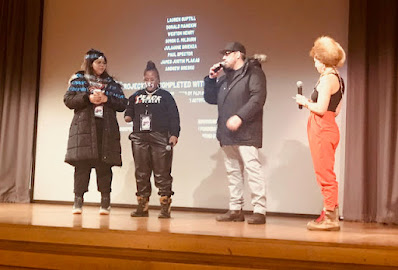That was the headline in the
story in the Anchorage Daily News about a shoplifting sting at Fred Meyer's on Northern Lights and New Seward Highway.
I'd been at a hearing on crime last year where lots of folks complained. Particularly some guys from Home Depot and Lowe's about shoplifters regularly walking out with big ticket items like chain saws, and how the stores did nothing because of SB91that made such arrests futile. One guy claimed they'd lost about $800,000 last year.
So this sting to catch shoplifters at Fred Meyer sounded like a good idea. About time. Until I read it. The fake fingernails should have been a red flag, though they turned out to be one of the more expensive items.
This program, called "Retail Detail" is, it says, a partnership with the big box store loss prevention teams and the Anchorage Police Department (APD), and began about six months ago. Well, that was just after that hearing I went to last October.
"Carson said about 20 police officers, both undercover and marked, took part in the shoplifting sting. The operation lasted about nine hours, from the afternoon into the night."
I don't know that all the police officers worked all nine hours or that they weren't doing other work and came when called. But let's say 10 officers for nine hours. Say t
heir pay is $32-42/hour and the
State Labor Department says the mean statewide pay for police/sheriff is $39 and the median is $40.
An Alaska Policy Forum report says on MOA salaries says that benefits are about 30% of salaries. Though that's an average and I'm guessing it's a bit higher for police. But let's use 30%.
So they'd be costing about $50/hour. Times ten (we're being conservative and assuming not all were working all nine hours) = $500. Times nine hours = $4500. This is an extremely conservative number because it doesn't count any time in preparation for this sting or follow up. This doesn't count the time of the loss prevention team members.
So what did they get? The headline says 25 suspects. I'm assuming these are arrests, not convictions. What grabbed my attention was the value of the merchandise of each shoplifter. From the article:
#1 [the article includes name and age, but I don't see the point here] "was arrested after he ran into the side of a patrol car on a stolen bicycle. Dickson had taken the bike from outside of the store. . . the bike brakes didn't work. #1 smashed into the side of the patrol car, causing "pretty good damage" to the rig."
So we have to add the cost of the damage to the rig. Not sure how much a bike with no brakes is worth. Not much I'm guessing. I'll put down
$20 which I think is generous. But it clearly wasn't store merchandise. Just a brakeless bike someone left there.
#2 hid fake fingernails worth $48.25 in his jacket pocket
#3A stole three cans of spray paint and ran from officers as #3B, sat waiting in a getaway vehicle, police say. #3A was arrested for theft, resisting arrest and violating conditions of release. #3B was arrested on two counts of misconduct involving a weapon
Fred Meyer's website wasn't very helpful (one kind of Spray Paint wasn't available at the Northern Lights store, another kind didn't have a price.)
At Walmart, spray paint ranges from $2.64 - $5.68. So let's say three cans were worth
$15.
#4 and a 13-year-old girl stole $103.86 worth of food. #4 was arrested for theft, contributing to the delinquency of a minor and violating conditions of release. The teenager was arrested and released to her parents.
Age might be relevant here if these two aren't relatives. He was 32.
#5 stole $47.83 worth of various merchandise. She was arrested for theft, and had an outstanding warrant for a probation violation.
#6A and #6B stole $215.17 worth of food and merchandise. Both were arrested for theft; #6A had an outstanding warrant for a probation violation.
#7 stole a comforter costing $34.99. He was arrested for theft.
#8 stole $11.16 in food. He was arrested for theft.
#9 stole $288.56 worth of merchandise. He was arrested for theft and failure to register as a sex offender.
#10 tried to run from the store with $40.55 worth of merchandise, but officers caught him. He was arrested for theft, resisting arrest and violating conditions of release.
#11 stole $5.48 worth of food. He was arrested for theft, and on an outstanding warrant for failure to appear in court.
#12 stole $13.69 in alcohol. He was arrested for theft.
#13 stole $54.99 in shoes. He had a concealed gun on him and didn't tell officers; he was arrested for theft and misconduct involving a weapon.
#14 stole $52.50 in shoes. He was arrested for theft.
#15 was recognized by employees as having an outstanding misdemeanor warrant for theft. She was arrested on the warrant.
#16 put $87.87 of merchandise in his backpack and walked out of the store. He had heroin on him. He was arrested for theft and misconduct involving a controlled substance.
#17 stole $22.98 in antifreeze. He was arrested for theft.
#18 was recognized by employees as a repeat trespass offender, and was arrested for trespassing.
#19 stole $6.59 of food. He was arrested for theft.
#20 was recognized by officers from two outstanding warrants: a felony warrant for promoting contraband and misconduct involving a controlled substance, and a misdemeanor warrant for failure to appear in court. She was arrested.
#21 stole $337.15 worth of assorted merchandise. She was arrested for theft.
#22 stole $221.22 in merchandise. She was arrested on an outstanding felony warrant for failure to appear in court, as well as theft and resisting arrest.
The headline says 25 suspects, but the numbers only go up to #22. There were two listed in #3, #4 (a 13 year old girl), and #6.
By the time I finished this list, I was nodding my head. Let's look at the numbers:
| Some Key Numbers |
25 arrests
Total value stolen = $1630 or $181/hour
Average amount(mean) = $74
Median = about $38 (two middle numbers were $35 and $41)
If you order from lowest to most, #16 is $19 below the average.
The last six accounted for $1254.
Conservative estimate of cost of sting: $4500
|
We're looking at a people who stole $5, $6, and $11 worth of food. Several people who hadn't taken anything, but were recognized by store employees as problems.
This doesn't reflect the stories I heard about Home Depot and Lowe's. Most of these sound like poor people - homeless? - who took small amounts.
I'm not saying there's no problem here. Fred Meyer is open (at least now) from 7am - 12 am, or 17 hours. For simplicity sake, let's calculate the other seven hours at the same rate. We get $3070 per day in theft. And assuming Fred Meyer is open every day, $1,123,470 a year. (We don't really know if this is an average day, a high day, or a low day, or if the hours they didn't work the sting had the same level of theft. So this is just a ball park guess.)
That's not peanuts. But is the cost of preventing those thefts greater than the costs of the thefts? For this particularly day it cost at least three times more than the value of the items stolen. (I'm assuming that my $4500 figure is way low.) Could the money be used in a way that prevented the most of the thefts instead of simply (temporarily for most) incarcerating the thieves.
Or, is there a certain number of shoplifters who cause the bulk of the problem - like the ones who took over $88 each? If they're removed would that cut the bulk of the problem? In this sting, six people were responsible for 77% of the value of the stolen goods. (from the table, $1254 (value taken by top six)/1630 (total value taken) = 77%)
Maybe there's some value to catching people with outstanding warrants or who violate their parole that goes beyond the value of what was stolen. Some of these might be clever thieves. But most sound like pretty desperate people. Maybe some who aren't so desperate, but have some mental health needs to shoplift. It's not clear how many of these people actually bought other items in addition to what they were stealing and how many just tried to walk out without paying anything.
I don't know the answer to this. Obviously social and mental health services for those who are unable to work or cannot find a job or hold one might help cut into this problem.
I just wanted to put all those costs together and match them to the cost of the sting. There may well be costs and benefits I've missed.
It may seem like a trivial issue, but the kind of thinking through the numbers and different ways to spend the money, different ways to lessen shoplifting, is the kind of thinking we should be applying to all sort of issues from immigration to terrorism. Arrests by law enforcement at Fred Meyer or on the border, or combat, only means that other means have failed, or haven't even been tried.


































